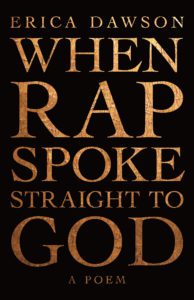
“Today I told Donald Trump / the story of a woman. How the skies / came out of her wherever. Spacious skies. / Dark Skies.” Erica Dawson’s third collection, When Rap Spoke Straight to God, is a book-length epic poem in four parts, and layers ancient and modern voices to craft a poignant response to the rise of Trump. Dawson’s exploration of the contemporary cultural and political moment delves into the indignities imposed upon black life by both the state and fellow citizens, especially those imposed upon women. The subject matter calls to mind Marie Howe’s Magdalene or Claudia Rankine’s Citizen: It is a soul-searching journey invoking biblical figures, that also delves into the intersection of the effects of racism and street harassment. Dawson’s poem differentiates itself in its unique form, displaying a lyrical and formal agility expressed through a collection of diverse voices. Whether by reimagining how Eve was formed or punching characters from fairy tales, Dawson examines and upends history and the present day by mixing and remixing the familiar with the new.
The way persona works in the collection is both fascinating and instructive. Take, for example, the appearance of the Virgin Mary, who says: “I was only half of thirty / when my body had its way with me. Much less / violent than you would think.” This refashions the Annunciation as imposition, in fact, as sexual violation. The characters invoked are sometimes embodied in a new gender, as in the example of a dramatic monologue of Lady Jesus:
________Go on. Do it. Deny
me, Peter.
___________I’m a maenad shape-
shifting inside a sheltered cave.And when the grave sky’s body farm
of gods and gutted animals
serves me, you’ll eat me, masticate
me with your tongue. My mouth, a bit
of gristle.
The new rage of this re-gendered savior contains a gale force similar to that of Plath’s “Lady Lazarus.” The ancient (yet new) Lady Jesus invokes Greek myth, comparing herself to a maenad, so that we get a further layering of possible selves. There is an elegance to the way the persona poems throughout When Rap Spoke Straight to God speak in accompaniment with the overarching contemporary speaker of the poem. Their voices working together create a forceful narrative that speaks to how the issues of our current political moment are larger than the moment itself.
This alternating between new-old and old-new is present in other themes of the collection:
_________________Oh beautiful for skies
too small.
_________________Today, the paper boasted this—
Five Local Policemen Tied to KKK—
italicized as if to shout, It’s new.
This.
This voice brings in the real-life headline from the newspaper into synthesis with the song “America the Beautiful.” We hear the revision: Something is wrong with the original description of America. Juxtaposed with the news headline, we also have the poet reminding us: None of this is new. This constant revision, questioning, and recovery enacts our current moment, in which we can never be sure what news is real or fake, which parts of the Trump nightmare are new or just something some of us didn’t pay attention to before. This is the crux of the book’s complexity—the work of wading through this murky space of pain and hope that feels so immediate and vivid it is sometimes even painful for the reader.
With the great triggering of our last presidential election season, and the #TimesUp and #MeToo hashtags, we’ve witnessed a collective resurfacing of memories of sexual abuse and harassment, and a new willingness to speak out about them. Dawson engages with these events and movements throughout the book. Instances of catcalls thread through the longer narrative and surface as lines of poetry: “at a gas station, a man’s Damn girl, those tits / knocks me into the pump and I, too, can / be machine. Shudder. Waiting for use. Tick. _____Queue.” There’s a rawness and immediacy here that stems from the presentation of an offensive catcall as “natural speech,” coupled with Dawson’s characteristic rhythm (that “Tick. Queue.”) that show how misogyny feels in the body.
Dawson plays with many tropes—light and dark, the spiritual vs. the corporeal—while questioning the everyday myths that surround us. The journey of the spiritual is not religious or irreligious. It is nuanced. At one point the speaker declares quite simply “I seek God.” At another, the speaker asserts herself: “I can do all things / through Christ which strengthenth me.” Similarly, the pop cultural and literary references throughout function as quasi-spiritual figures that commune with or occupy the space of gods:
When Jeezy said____ Jesus said_____ the sky’s
our only limit, rap asked God who deferred
it to the dirt interred around the incus,
the anvil of the ear’s middle passage.
In this example, we get more layering of voices: the rapper Young Jeezy invoking the religious figure, Jesus, contemporary vs. ancient, speaker on speaker. There is also the sky vs. dirt: dirt-as-grave operates as a counterpoint to sky-as-opportunity. Yet the sentence slips our expectations. The dirt is actually found inside the middle ear rather than in the earth. Dawson uses the anatomical name “incus,” also called the anvil, which is the part of the ear that transmits sound. Thus, the dirt in the ear is blocking the message. At the same time, we get the invocation of the “middle passage,” the journey of slave ships, referencing America’s original sin as that which stifles opportunity for people of color, and turns it into a part of the body. What Dawson does really well is emotional compression; what this means for the reader is that you must do some unpacking, but it is work rewarded.
Fans of traditional verse forms may already have Dawson on their radar from her previous collections, but in this one, the mash-up of forms within the longer epic poem does something unique. I had the impulse to go on a kind of traditional forms scavenger hunt within the book – here is a sestina! here is a sonnet!—but ultimately had to curb that impulse. Dawson says, “See, I have a thing for dead white guys. / Right now, Robert Herrick.” That the literary canon lacks representation of traditionally marginalized groups is obvious. The forms Dawson employs have long been considered the domain of “dead white guys.” In When Rap Spoke Straight to God, Dawson carves a space within the tradition for her own innovative voice: Here is a black female voice simultaneously working out of that tradition, and against that tradition, making it wholly new. Further, she draws a direct line between Robert Herrick and Young Jeezy, Milton and Lil’ Kim, connecting poetry and rap as sister arts. Indeed, we might consider the rhythm of language in rap lyrics as akin to the iambic line. The overall effect of this mash-up of forms is that it is more difficult to trace the original pattern; the form will have to do its work without being identified.
One example where the formal elements, rhyme and repetition, can be heard quite clearly comes towards the end of the poem:
I see the exodus of light.
________________________________Let there
be not afraid, for you are with the fair
and mighty god of your body. ______Stare.
Be skin born back on every scar and tear
that undershirt, brother. Let us all bare
our weight. Let there be loose. And then, let there.
Dawson reverses the biblical reference from Genesis “let there be light” by observing its exodus. The phrase “let there” repeats and repeats, gaining force as a kind of remaking of the world. The rhyme (there, fair, stare, tear, bare) is a pillar that we return to at the end of each line.
This collection is a slim volume, but it is heavy. The arrangement of poems within one longer poem disrupts the reader’s desire for order in simple digestible packets—but that would not do justice to the subject matter. If you find yourself wrestling with the reality and surreality of the current political moment, Dawson’s book is worth a read, offering a valuable perspective, an attempt to sift through a harsh, surreal landscape.
We often turn to poetry when we seek solace. We might turn to this poetry when we are not yet ready to be consoled.
***
Photograph of Erica Dawson © Kevin Kelii.





